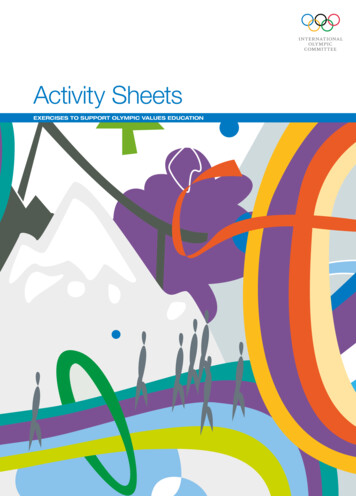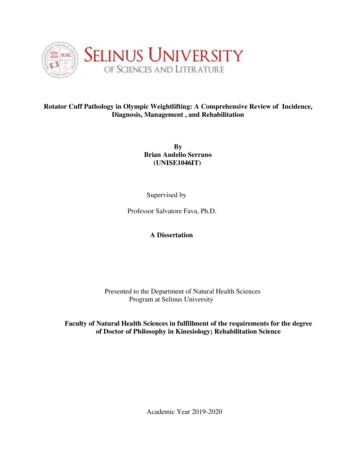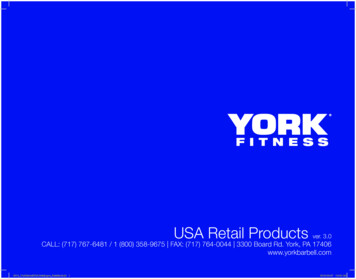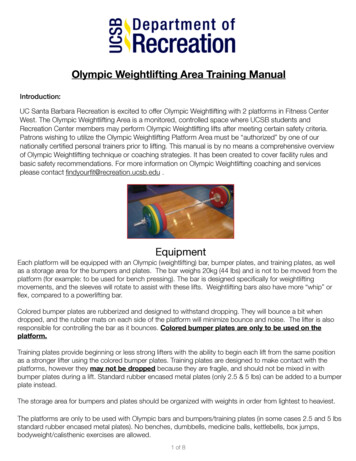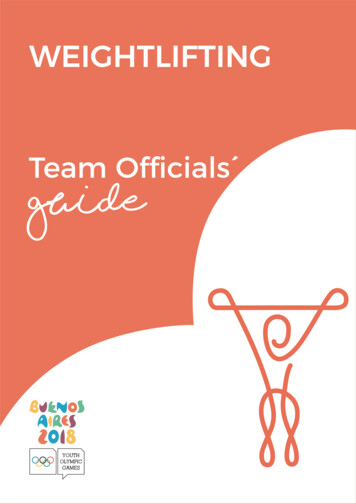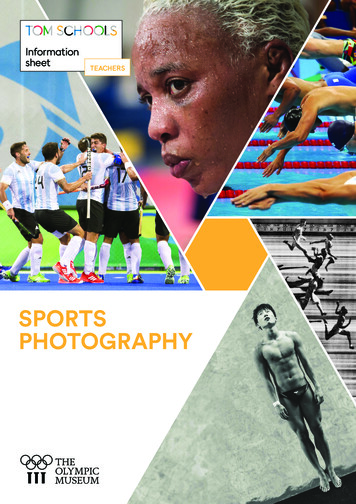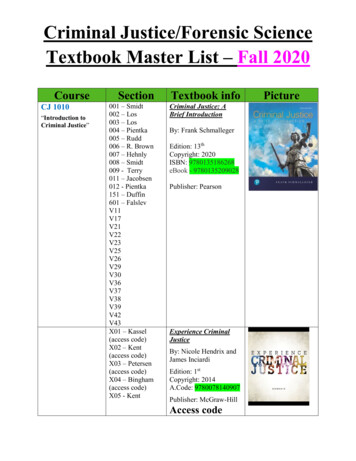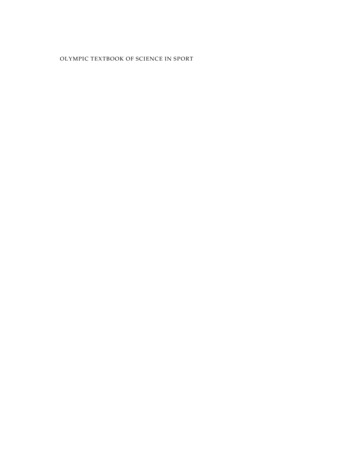
Transcription
9781405156387 1 pre.qxd9/11/0813:08Page iOLYMPIC TEXTBOOK OF SCIENCE IN SPORT
9781405156387 1 pre.qxd9/11/0813:08Page ii
9781405156387 1 pre.qxd9/11/0813:08Page iiiO LY M P I C T E X T B O O K O FS C I E N C E I N S P O RTVOLUME XV OF THE ENCYCLOPAEDIA OF SPORTS MEDICINEAN IOC MEDICAL COMMISSION PUBLICATIONEDITED BYRONALD J. MAUGHAN, PhDA John Wiley & Sons, Ltd., Publication
9781405156387 1 pre.qxd9/11/0813:08Page ivThis edition first published 2009, 2009 International Olympic CommitteePublished by Blackwell Publishing LtdBlackwell Publishing was acquired by John Wiley & Sons in February 2007. Blackwell’s publishing programhas been merged with Wiley’s global Scientific, Technical and Medical business to form Wiley-Blackwell.Registered office: John Wiley & Sons Ltd, The Atrium, Southern Gate, Chichester, West Sussex, PO19 8SQ, UKEditorial offices: 9600 Garsington Road, Oxford, OX4 2DQ, UKThe Atrium, Southern Gate, Chichester, West Sussex, PO19 8SQ, UK111 River Street, Hoboken, NJ 07030-5774, USAFor details of our global editorial offices, for customer services and for information about how to apply forpermission to reuse the copyright material in this book please see our website at www.wiley.com/wileyblackwellThe right of the author to be identified as the author of this work has been asserted in accordance with theCopyright, Designs and Patents Act 1988.All rights reserved. No part of this publication may be reproduced, stored in a retrieval system, ortransmitted, in any form or by any means, electronic, mechanical, photocopying, recording or otherwise,except as permitted by the UK Copyright, Designs and Patents Act 1988, without the prior permission of thepublisher.Wiley also publishes its books in a variety of electronic formats. Some content that appears in print may not beavailable in electronic books.Designations used by companies to distinguish their products are often claimed as trademarks. All brandnames and product names used in this book are trade names, service marks, trademarks or registeredtrademarks of their respective owners. The publisher is not associated with any product or vendor mentionedin this book. This publication is designed to provide accurate and authoritative information in regard to thesubject matter covered. It is sold on the understanding that the publisher is not engaged in renderingprofessional services. If professional advice or other expert assistance is required, the services of a competentprofessional should be sought.The contents of this work are intended to further general scientific research, understanding, and discussiononly and are not intended and should not be relied upon as recommending or promoting a specific method,diagnosis, or treatment by physicians for any particular patient. The publisher and the author make norepresentations or warranties with respect to the accuracy or completeness of the contents of this work andspecifically disclaim all warranties, including without limitation any implied warranties of fitness for aparticular purpose. In view of ongoing research, equipment modifications, changes in governmentalregulations, and the constant flow of information relating to the use of medicines, equipment, and devices, thereader is urged to review and evaluate the information provided in the package insert or instructions for eachmedicine, equipment, or device for, among other things, any changes in the instructions or indication of usageand for added warnings and precautions. Readers should consult with a specialist where appropriate. Thefact that an organization or Website is referred to in this work as a citation and/or a potential source of furtherinformation does not mean that the author or the publisher endorses the information the organization orWebsite may provide or recommendations it may make. Further, readers should be aware that InternetWebsites listed in this work may have changed or disappeared between when this work was written andwhen it is read. No warranty may be created or extended by any promotional statements for this work.Neither the publisher nor the author shall be liable for any damages arising herefrom.Library of Congress Cataloging-in-Publication DataThe Olympic textbook of science in sport / edited by Ron J. Maughan.p. ; cm. – (Encyclopaedia of sports medicine ; v. 15)“An IOC Medical Commission publication.”Includes bibliographical references and index.ISBN 978-1-4051-5638-71. Sports–Physiological aspects. 2. Physical fitness–Physiological aspects. 3. Human mechanics.I. Maughan, Ron J., 1951- II. IOC Medical Commission. III. Series.[DNLM: 1. Sports–physiology. 2. Athletic Performance. 3. Biomechanics. 4. Exercise.5. Nutrition Physiology. 6. Sports Medicine–methods. QT 13 E527 1988 v.15]RC1235.O59 2008613.7′11–dc222008024090ISBNs: 978-1-4051-5638-7978-1-4051-9257-6 (leather bound)A catalogue record for this book is available from the British Library.Set in 9/12 pt Palatino by Graphicraft Limited, Hong KongPrinted and bound in Malaysia by Vivar Printing Sdn Bhd12009
9781405156387 1 pre.qxd9/11/0813:08Page vContentsList of Contributors, viiForeword, ixPreface, xIntroduction: Sport, Science and SportsScience, 1ronald j. maughanPart 1: Physiology and Biochemistry1Muscle: Producing Force and Movement, 7paavo v. komi andmasaki ishikawa2Physiological Demands of Sprinting andMultiple-Sprint Sports, 25clyde williams3Physiological Demands of EnduranceExercise, 43andrew m. jones and david c. poole4Physiological Adaptations to Training, 56martin j. gibala andmark rakobowchuk5Skeletal Muscle Metabolic Adaptations toTraining, 70graham p. holloway andlawrence l. sprietPart 2: Nutrition6Nutrition Needs of Athletes, 87ronald j. maughan7Dietary Goals and Eating Strategies, 101louise m. burke8Hydration, 116susan m. shirreffsPart 3: Anthropometry9Body Composition and Sports Performance, 131timothy oldsPart 4: Immunology10Exercise Immunology, 149michael gleeson11Exercise, Inflammation, and Metabolism, 163ben te k. peders enPart 5: Cell Biology12Genetic Determinants of PhysicalPerformance, 181claude bouchard andtuomo rankinen13Molecular Mechanisms of Adaptations toTraining, 202frank w. booth and p. darrell neufer
9781405156387 1 pre.qxdvi9/11/0813:08Page vicontentsPart 6: Biomechanics, Engineering, andErgonomics1415Biomechanics of Human Movement andMuscle-Tendon Function, 215vasilios baltzopoulos andconstantinos n. maganarisPart 9: Limitations to Performance19Cardiorespiratory Limitations toPerformance, 307niels h. secher20Metabolic Limitations to Performance, 324francis b. stephens andpaul l. greenhaff21The Brain and Fatigue, 340timothy d. noakes, helen creweand ross tuckerSports Ergonomics, 230thomas reilly and adrian leesPart 7: Psychology1617Exercise and Psychological Well-being, 251panteleimon ekkekakis andsusan h. backhousePsychological Characteristics of Athletesand their Responses to Sport-RelatedStressors, 272john s. raglin and gregory wilsonPart 10: Special Populations22The Young Athlete, 365lyle j. micheli and margo mountjoy23The Female Athlete, 382myra a. nimmoPart 8: PharmacologyPart 11: Exercise and Health1824Performance-Enhancing Drugs, 285mario thevis andwilhelm schänzerHealth Benefits of Exercise and PhysicalFitness, 401michael j. lamonte, karl f.kozlowski and frank cernyIndex, 417
9781405156387 1 pre.qxd9/11/0813:08Page viiList of ContributorsSUSAN H. BACKHOUSE PhD, CarnegieResearch Institute, Leeds Metropolitan University, Leeds, UKMICHAEL GLEESON PhD, School of Sportand Exercise Sciences, Loughborough University,Loughborough, UKVASILIOS BALTZOPOULOS PhD, Institutefor Biomedical Research into Human Movement and Health,Manchester Metropolitan University, Manchester, UKFRANK W. BOOTH PhD, Department ofBiomedical Sciences, Medical Pharmacology, andPhysiology, University of Missouri, Columbia,MO, USAPAUL L. GREENHAFF PhD, Centre forIntegrated Systems Biology and Medicine, School ofBiomedical Sciences, University of Nottingham MedicalSchool, Queen’s Medical Centre, Nottingham, UKGRAHAM P. HOLLOWAY PhD, Departmentof Human Health and Nutritional Sciences, University ofGuelph, Guelph, Ontario, CanadaCLAUDE BOUCHARD PhD, PenningtonBiomedical Research Center, Baton Rouge, LA, USALOUISE M. BURKE PhD, APD, Department ofSports Nutrition, Australian Institute of Sport, Bruce, ACT,Australia, and Deakin University, Melbourne, Victoria,AustraliaFRANK CERNY PhD, Department of Exercise andNutrition Science, School of Public Health and HealthProfessions, State University of New York at Buffalo,Buffalo, NY, USAMASAKI ISHIKAWA PhD, Department of Healthand Sport Management, Osaka University of Health andSport Sciences, Osaka, JapanANDREW M. JONES PhD, School of Sport andHealth Sciences, University of Exeter, Exeter, UKPAAVO V. KOMI PhD, Department of the Biologyof Physical Activity, University of Jyväskylä, Jyväskylä,FinlandKARL F. KOZLOWSKI EdM, Department ofHELEN CREWE BSc (Hons), UCT/MRC ResearchUnit for Exercise Science and Sports Medicine, Departmentof Human Biology, University of Cape Town, Newlands,South AfricaExercise and Nutrition Science, School of Public Healthand Health Professions, State University of New York atBuffalo, Buffalo, NY, USAMICHAEL J. LAMONTE PhD, Department ofPANTELEIMON EKKEKAKIS PhD,Department of Kinesiology, Iowa State University, Ames,IA, USASocial and Preventive Medicine, School of Public Health andHealth Professions, State University of New York at Buffalo,Buffalo, NY, USAMARTIN J. GIBALA PhD, Exercise MetabolismADRIAN LEES PhD, Research Institute for Sport andResearch Group, Department of Kinesiology, McMasterUniversity, Hamilton, Ontario, CanadaExercise Sciences, Liverpool John Moores University, HenryCotton Campus, Liverpool, UK
9781405156387 1 pre.qxdviii9/11/0813:08Page viiilist of contributorsCONSTANTINOS N. MAGANARISPhD, Institute for Biomedical Research into HumanMovement and Health, Manchester MetropolitanUniversity, Manchester, UKMARK RAKOBOWCHUK MSc, ExerciseMetabolism Research Group, Department of Kinesiology,McMaster University, Hamilton, Ontario, CanadaTUOMO RANKINEN PhD, PenningtonRONALD J. MAUGHAN PhD, School ofBiomedical Research Center, Baton Rouge, LA, USASport and Exercise Sciences, Loughborough University,Loughborough, UKTHOMAS REILLY DSc, Research Institute for SportLYLE J. MICHELI MD, Harvard Medical School,and Exercise Sciences, Liverpool John Moores University,Henry Cotton Campus, Liverpool, UKand Division of Sports Medicine, Children’s HospitalBoston, Boston, MA, USAMARGO MOUNTJOY MD, Health &WILHELM SCHÄNZER PhD, Center forPreventive Doping Research, Institute of Biochemistry,German Sport University, Cologne, GermanyPerformance Centre, University of Guelph, Guelph,Ontario, CanadaNIELS H. SECHER MD, DMSc, Department ofP. DARRELL NEUFER PhD, DepartmentAnaesthesia, Rigshospitalet, University of Copenhagen,Copenhagen, Denmarkof Exercise and Sports Sciences, and Department ofPhysiology, East Carolina University, Greenville,NC, USASUSAN M. SHIRREFFS PhD, School of Sportand Exercise Sciences, Loughborough University,Loughborough, UKMYRA A. NIMMO PhD, School of Sport andExercise Sciences, Loughborough University,Loughborough, UKLAWRENCE L. SPRIET PhD, Departmentof Human Health and Nutritional Sciences, Universityof Guelph, Guelph, Ontario, CanadaTIMOTHY D. NOAKES MBChB, MD, DSc,UCT/MRC Research Unit for Exercise Scienceand Sports Medicine, Department of HumanBiology, University of Cape Town, Newlands,South AfricaTIMOTHY OLDS PhD, Nutritional PhysiologyResearch Centre, University of South Australia, Adelaide,AustraliaBENTE K. PEDERSEN MD, DMSc, Centreof Inflammation and Metabolism, Rigshospitalet 7641,Copenhagen, DenmarkFRANCIS B. STEPHENS PhD, Centre forIntegrated Systems Biology and Medicine, School ofBiomedical Sciences, University of Nottingham MedicalSchool, Queen’s Medical Centre, Nottingham, UKMARIO THEVIS PhD, Center for PreventiveDoping Research, Institute of Biochemistry, GermanSport University, Cologne, GermanyROSS TUCKER PhD, UCT/MRC Research Unitfor Exercise Science and Sports Medicine, Department ofHuman Biology, University of Cape Town, Newlands,South AfricaDAVID C. POOLE PhD, DSc, School of Sportand Health Sciences, University of Exeter, Exeter,UK, and Departments of Kinesiology, Anatomy andPhysiology, Kansas State University, Manhattan,KS, USACLYDE WILLIAMS PhD, School of Sportand Exercise Sciences, Loughborough University,Loughborough, UKGREGORY WILSON PED, Department ofJOHN S. RAGLIN PhD, Department of Kinesiology,Indiana University, Bloomington, IN, USAExercise and Sport Science, University of Evansville,Evansville, IN, USA
9781405156387 1 pre.qxd9/11/0813:08Page ixForewordThe general aim of all volumes in the series, Encyclopaedia of Sports Medicine, is the enhancement of the healthand welfare of athletes at all levels of competition in all parts of the world.The most respected scientific investigators and clinicians have collaborated to produce each volume of thecollection which contains reference texts that are both comprehensive for the topics and representative of theleading edge of knowledge.Volume XV, The Olympic Textbook of Science in Sport, reexamines the biochemical, physiological, and biomechanical issues that were included in the original Volume I in 1988 and synthesizes the new research information that has been published during the last 20 years. I wish to congratulate Professor Ronald Maughan andall of the Contributing Authors on the excellent quality of their efforts and welcome this volume to theEncyclopaedia series.Dr Jacques RoggePresident of the International Olympic Committee
9781405156387 1 pre.qxd9/11/0813:08Page xPrefaceAs the standards of sporting excellence continue torise to ever higher levels, so the scientific study ofsport also continues to evolve. The Medical Commission of the International Olympic Committee hasrecognised that science is not parochial or nationalistic, but rather that scientific knowledge should beavailable to all athletes. As part of its mission to support athletes and those sports scientists from manydifferent disciplines who, in turn, support them, theIOC Medical Commission decided to commission aTextbook of Science in Sport. The concept was of anencyclopaedia of sports science. An encyclopaediashould be a book or set of books giving informationon many subjects or on many aspects of one subject:it should be both comprehensive and authoritative.The aim of this encyclopaedia therefore is to providereviews of the many disciplines that comprise thesports sciences. To do so, a cast of leading expertsfrom many countries was recruited as authors. Theseauthors have given generously of their time andexpertise and to them the credit is due for this volume.I would like to extend special thanks to Howard“Skip” Knuttgen for his unfailing support in drivingthis project to its conclusion. His vast experience asCoordinator of Scientific Publications for the IOCMedical Commission has been an enormous asset atevery stage of the process.I am also deeply grateful to Victoria Pittmanand Cathryn Gates, Development Editors at WileyBlackwell in Oxford, and to Alice Nelson who wasproduction manager. All did an excellent job andensured that the project remained on track.Ronald J. Maughan, PhD
9781405156387 4 000.qxd9/11/0813:07Page 1Introduction: Sport, Science and Sports ScienceRONALD J. MAUGHANSport occupies a prominent place in modern societyand successful athletes enjoy a high level of financial and social reward, so there are considerableincentives to succeed. There are also many obstaclesto success: the sportsman or woman who succeedsat the highest level faces bigger challenges than everbefore. Although the falling rate of participation insport and physical activity has been a major factor inthe epidemic of obesity and related lifestyle diseasesthat has afflicted many countries in the last coupleof decades, more people than ever before are participating in organized sport. This has brought agreater part of the human gene pool into play thanwas the case a century ago when the luxury of participating in sport was open to only a privileged fewfrom a small number of countries. In many sports,the participation of women on a competitive basisis a recent phenomenon and female standards continue to rise rapidly as women catch up with theirmale counterparts.There are many different factors that may contribute to success in sport, and the components ofsuccess will vary depending on the particular sport.Scientists, coaches, and athletes may argue about theterminology used, but some of the key characteristics that contribute to success in all sports are:1 Talent;2 Training;3 Trainability;4 Physical dimensions and body composition;The Olympic Textbook of Science in Sport, 1st edition. Editedby R.J. Maughan. Published 2009 by Blackwell Publishing.ISBN: 978-1-4051-5638-7.5 Motivation, tactical awareness, and other psychological characteristics;6 Resistance to injury;7 Nutritional status; and8 Skill, technique, and related motor control andbiomechanical considerations.Of these, talent – which is determined entirely bygenetic endowment – is undoubtedly the key, butmany talented athletes fail to succeed at the highestlevel. Genetically gifted athletes who lack the motivtion to train consistently and intensively will notrealize their genetic potential. Some of the components listed above are only conditional requirements; for example, a good selection of foods alonewill not improve fitness in the absence of training.Likewise, the talented athlete who trains hard butwho makes poor food choices is unlikely to be assuccessful as they could be.Why should scientists study sport?For some, especially perhaps those engaged in thestudy of the social sciences, the study of sport is anend in itself, an attempt to understand the mutualinteractions between sport and society. For thoseinterested in the biological sciences, the study ofelite athletes offers an opportunity to study individuals at the extremes of the human gene pool whohave subjected themselves to extremes of trainingover prolonged periods of time. By studying theseextremes, new insights can be gained into normalhuman function.Needless to say, many scientists study the scienceof athletic endeavor because of a strong personal1
9781405156387 4 000.qxd29/11/0813:07Page 2introductioncommitment to sport and exercise. It is not oftenappreciated that A.V. Hill, whose pioneering workon muscle physiology earned him a share (withOtto Meyerhof) of the 1922 Nobel Prize in Physiology or Medicine, was himself an accomplishedathlete. His reported times of approximately 53 sfor 440 yards (401 m) and 2 min 3 s for 880 yards(802 m; Hill & Lupton 1923) indicate a considerabledegree of sporting talent, bearing in mind that limited training was the norm at that time. A generationlater, Roger Bannister, the first man to break the4-min mile barrier in 1954 and later a successful neurologist, spent time working in Cunningham’sphysiology laboratory in Oxford and, in that sameyear, published a paper on the respiratory and performance effects of breathing hyperoxic mixturesduring exercise (Bannister & Cunningham 1954).Another holder of the World Mile Record andtriple Olympic Gold medalist, Peter Snell, has alsopursued a highly successful career as an exercisephysiologist.Many exercise scientists also have considerableexperience of participation as experimental subjectsin their own investigations. Indeed, this is perhapsthe norm rather than the exception. J.B.S. Haldanewas perhaps the most reckless of self-experimenters,and almost died on a number of occasions whileresearching underwater physiology for the BritishAdmiralty during the Second World War. The twosubjects whose muscle glycogen responses to exercise and subsequent carbohydrate feeding werereported in a classic paper published in Nature in1966 were in fact the authors, Jonas Bergstrom andEric Hultman (Bergstrom & Hultman 1966). PhilGollnick, whose cardiac problems led to the fittingof a heart pacemaker, experimented on himselfto establish his own cardiovascular responses toexercise of different intensities at fixed heart rates.Paavo Komi was the first volunteer for a seriesof studies measuring the forces generated in thehuman tendon using a transducer implanted aroundthe Achilles tendon (Komi et al. 1987). This personaldimension can, of course, be a two-edged sword. Onthe one hand, the personal experience of exercisecan provide insights that would not arise from mereobservation alone. On the other hand, however,there is the danger that personal experience, with allthe beliefs and prejudices that accompany it, willintrude on the scientific method and will bias theobserver.It is also true, of course, that a significant number of exercise physiologists have little interest insport. Rather, they use exercise as a tool to studynormal physiology. Often, these studies provide insights that can benefit the sports community, butthis is a by-product of the research rather than anend in itself. The functional characteristics of manytissues are fully revealed only when the body isengaged in exercise. Resting skeletal muscle hassome unique metabolic properties, but only whenthe responses of muscle to differing exercise challenges are studied do these characteristics becomeapparent.The normal heart at rest can cope comfortablywith the demands of the organism for the supply ofoxygen. This is achieved with a cardiac outputof about 5 L·min 1, which in turn is met by a heartrate of about 70 beats·min 1 and a stroke volume ofabout 70 mL. During exercise, both heart rate andstroke volume increase to meet the increased oxygendemands, but there is an upper limit to the levelsof both that can be achieved. For ‘normal’ adults,this is reached at a heart rate of approximately200 beats·min 1 and a stroke volume of approximately 100–125 mL, giving a maximum cardiac output in the region of 20–25 L·min 1. The elite maleendurance athlete, however, can achieve cardiacoutputs in excess of 40 L·min 1, even though themaximum heart rate remains unchanged or mayeven be decreased, meaning that the maximum strokevolume is in excess of 200 mL (Ekblom & Hermansen1968). Such values are never seen in sedentary individuals. Accompanying changes in the capacity ofthe heart to deliver blood to the periphery are localchanges within the muscle; for example, a greatlyincreased capillary network allows the blood muchcloser contact with each individual muscle fiber(Andersen 1975) and the muscles themselves have agreatly increased capacity for oxidative metabolism(Holloszy 1967).These physical and metabolic adaptations cango a long way towards explaining the incredibleexercise performance of the elite athlete. In the exercise physiology laboratory, healthy and recreationally
9781405156387 4 000.qxd9/11/0813:07Page 3introductionactive young males can sustain a power output ofperhaps 150 W for an hour; the cyclist who wants tobreak the 1-hour World Track Record must sustain a power output in excess of about 460 W. Likewise, the elite male marathon runner who wants tobreak Haile Gebreselassie’s current World Recordof 2 h 4 min 26 s must run at an average speed of5.65 m·s 1, or 20.3 km·h 1; while the woman seeking to break Paula Radcliffe’s record of 2 h 15min 25 s must run only slightly slower than this.Even those who consider themselves to be veryfit cannot run at these speeds for more than a fewminutes.In part these performances reflect the geneticendowment of the elite athlete and considerableeffort is being devoted to identifying the possiblegenetic mutations that are associated with outstanding performance. However, many people who dohave the genetic make-up either do not have theopportunity to be involved in sport because ofsocio-cultural limitations or because they simplychoose not to participate. An understanding of themotivations of athletes and the factors that predispose participation in sport may help our understanding of why so many in the general populationshun exercise at every opportunity, even thoughthey are well aware of the health risks that accompany a sedentary life. There are good animal modelsto show that there is a strong genetic component tothe predisposition to participation, and some inbredstrains of rats show compulsive running behaviors,similar to those of some athletes (Makatsori et al.2003). An understanding of the neurochemical processes involved may help to determine why somepeople choose to be active in their spare time whileothers avoid all unnecessary exercise.Sports science supportAs the rewards in sport have increased, an industryhas grown up to provide support for participants.The elite athlete is only one member of a team thatwill include a coach, fitness specialists, advisers ontactics and technique, a medical doctor, and a physiotherapist, and perhaps also a physiologist, psychologist, nutritionist/dietitian, biomechanist, and aperformance analyst, as well as several others. Each3of these professionals plays – or at least shouldplay – a vital role in ensuring that the athlete canundertake the rigorous training that is a prerequisite of success. They will also ensure that the athlete is prepared for competition by addressing allof the problems that may prevent optimum performance. One challenge facing those who seek toapply science to sports performance is the fact thatessentially all of the published research is based onnon-elite athletes. Indeed, most published studies inareas such as exercise physiology and biochemistryhave used subjects that were not athletes at all.This is usually because athletes are not prepared todisrupt training or preparation for competition byparticipating in experiments. They are also understandably reluctant to take part in invasive studiesthat involve repeated blood sampling, muscle biopsies, or other invasive procedures, although theintroduction of non-invasive techniques for the analysis of muscle function, such as magnetic resonancespectroscopy, has made it possible to study theeffects of interventions on national level athletes(e.g., Derave et al. 2007).It is also important to recognize that statisticalsignificance, as described in most experimental investigations, may have little relevance in the worldof elite sport where the margin between victoryand defeat can be vanishingly small. Most laboratory studies are not designed for this purpose and amore useful concept may be the “smallest worthwhile effect”, as described by Hopkins (2006). Animportant element of this concept is to recognizethe existence of individual differences in responsesthat make population estimates irrelevant to theindividual athlete. This is perhaps the key difference between the sports scientist and the scientistwho studies sport: the former is concerned withoptimizing the health and performance of the individual athlete, while the latter is focused on thepopulation as a whole. In the study by Derave et al.(2007) cited above, there was no beneficial effect ofsupplementation with β-alanine on 400-m runningperformance in well-trained runners, even thoughthis supplement is used widely by athletes.Both of these approaches are perfectly valid, andthe scientist with an interest in sport will switchbetween these approaches. It is this combination of
9781405156387 4 000.qxd49/11/0813:07Page 4introductiondeep insight and practical relevance that makes thesports sciences so rewarding for all who work inthis area.Sport, exercise and healthIt is easy to forget that the common perception, notso long ago, was that participation in sport waslikely to shorten, rather than prolong, life (Polednak1979). Even very recently, the focus of a UK government intervention aimed at reducing the prevalenceof coronary disease was on smoking cessation anddiet, with no mention of physical activity (DHSS1987). Today, as a large part of the world confrontsthe consequences of the obesity epidemic, this seemshardly credible. The role of exercise as a crucialelement in any lifestyle intervention targeted atnon-communicable diseases has gained widespread,though still not universal, acceptance. Translatingthis into practice, however, remains a formidablechallenge. Today, many who take regular exercise athealth clubs have no desire to participate in organized sports, but their commitment to exercise is noless for that. The sports sciences today embrace thestudy of physical activity and health as an important area. Even those whose primary concern is withthe performance of athletes recognize that they alsoneed to stay healthy, both while they are competingand in the years after retirement from serious competition. Many exercise scientists have emerged,however, with little interest in sport but with astrong desire to understand the consequences ofactive or sedentary lifestyles.Sports science is therefore different things to different people. No-one should doubt, though, thatnew developments in this dynamic area of scienceaffect all our lives.This book aims to provide an introduction to thecore disciplines that comprise the sports sciences.It includes reviews by recognized experts who bringa wealth of experience to bear on the fundamentalsciences and on their application to elite sport.ReferencesAndersen, P. (1975) Capillary densityin skeletal muscle of man. ActaPhysiologica Scandinavica 95,203 – 205.Bannister, R.G. & Cunningham, D.J.C.(1954) The effects on the respiration andperformance during exercise of addingoxygen to the inspired air. Journal ofPhysiology 125, 118–137.Bergstrom, J. & Hultman, E. (1966)Muscle glycogen synthesis afterexercise: an enhancing factor localisedto the muscle cells in man. Nature 210,309 – 310.Derave, W., Ozdemir, M.S., Harris, R.C.,Potter, A. Reyngoudt, H., Koppo, K.,et al. (2007) β-Alanine supplementationaugments muscle carnosine contentand attenuates fatigue during repeatedisokinetic contraction bouts in trainedsprinters. Journal of Applied Physiolog
Part 2: Nutrition 6 Nutrition Needs of Athletes, 87 ronald j. maughan 7 Dietary Goals and Eating Strategies, 101 louise m. burke 8 Hydration, 116 susan m. shirreffs Part 3: Anthropometry 9 Body Composition and Sports Performance, 131 timothy olds Part 4: Immunology 10 Exercise Immunolo
